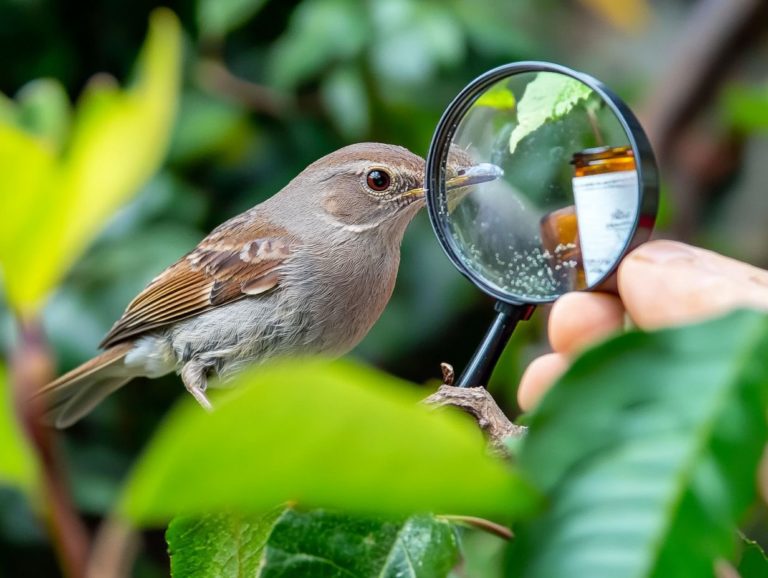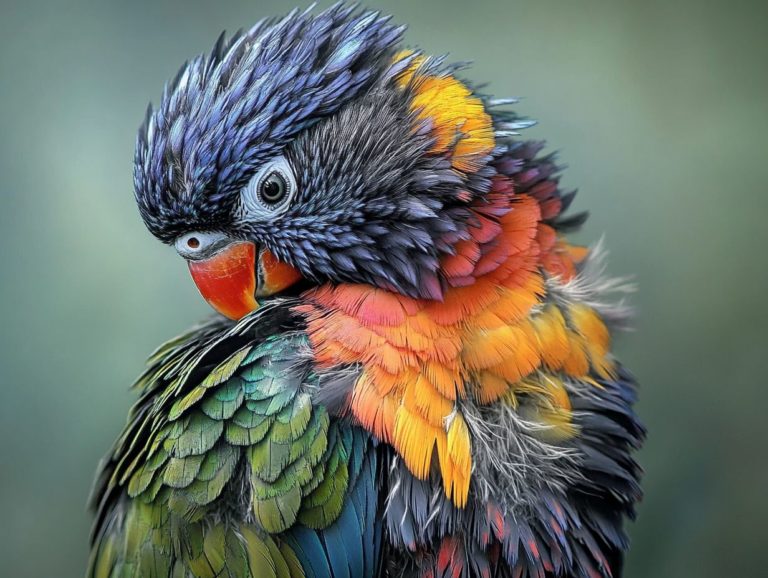Understanding Bird Molting: What to Expect
Bird molting is a captivating and vital process that every feathered companion experiences. Whether you re an experienced bird owner or just starting your avian adventure, understanding the details of molting will empower you to recognize its signs. You ll also learn how to effectively support your pet during this natural cycle.
This article explores the different types of molting, the triggers behind these changes, and how to identify the physical signs. It also offers practical tips to ensure your bird stays comfortable throughout the molting process.
Join in as you unravel the mysteries of bird molting and discover how to care for your feathery friend during this important phase!
Contents
Key Takeaways:

- Bird molting is a natural process in which birds shed old feathers and replace them with new ones, ensuring a healthy cycle of plumage.
- Molting can be complete or incomplete, and is triggered by factors such as seasonal changes and breeding cycles.
- During molting, birds may show physical changes and behaviors like increased preening, occasional plucking, and decreased appetite. It’s important to provide them with proper care and nutrition during this time.
What is Bird Molting?
Bird molting is a fascinating natural process where birds shed and regrow their feathers in distinct cycles. This process plays a crucial role in their overall health and well-being. It is observed in a range of bird species, including beloved pet parrots like Macaws, African Greys, and Cockatiels.
During molting, old, worn feathers are shed to make room for fresh plumage. This enhances insulation and comfort across different seasons. By understanding the molting process, you can give the essential care and attention your feathered companions need to thrive during this important stage of their lives.
Definition and Explanation
Bird molting is the systematic shedding and regrowth of feathers, a crucial process that directly impacts your bird’s health, insulation, and overall appearance.
This captivating biological phenomenon helps your bird control its temperature. It also improves flight ability and helps attract mates. During molting, different types of feathers are shed and regrown think contour feathers for a sleek look and down feathers for warmth.
The timing and pattern of this process can vary greatly among species. For instance, waterfowl often undergo a simultaneous molt, replacing all their flight feathers at once, whereas songbirds may take a more gradual approach to feather regeneration.
Understanding these variations provides valuable insight into the adaptability and evolutionary strategies of avian species, enriching your understanding of the natural world.
Types of Molting in Birds
There are two primary types of molting in birds: complete molting and incomplete molting. Each type plays a vital role in a bird’s lifecycle, ensuring proper insulation and comfort.
Complete molting usually occurs during specific seasons, allowing birds to shed all their feathers at once. In contrast, incomplete molting involves a more gradual feather replacement that can differ based on the species and the bird’s age, whether it’s a juvenile or an adult.
Complete vs. Incomplete Molting
Complete molting involves the simultaneous shedding of all feathers, while incomplete molting entails a gradual replacement. This process greatly affects how well a bird stays warm and its appearance.
During complete molting, you might observe a stunning transformation in birds like the American Goldfinch. After the breeding season, these birds often lose their old feathers all at once, unveiling a brand-new plumage. This dramatic change can unfold over several weeks and typically occurs annually, gearing up for the chill of winter.
In contrast, some species, such as the European Starling, undergo incomplete molting. Here, feathers are replaced incrementally over an extended period, which can extend throughout the year. This gradual replacement ensures continuous insulation and effective camouflage, subtly influencing their behavioral patterns.
From a health perspective, both types of molting can affect a bird’s ability to regulate temperature and engage socially. This highlights just how vital feather quality is in the avian world.
Have you noticed your bird acting differently during molting? Implement the tips shared in this article to ensure your pet thrives during this fascinating stage!
When and Why Birds Molt

Birds undergo molting at specific times of the year, usually influenced by natural events linked to breeding times, temperature fluctuations, and environmental stressors. Seasonal molting helps birds adjust their feathers for warmth and protection.
By doing so, they make sure their feathers remain in peak condition for flight and survival across diverse climates, providing essential insulation and energy.
Triggers and Natural Cycles
Various triggers and natural cycles influence when you might see birds molting, including shifts in light exposure and temperature fluctuations.
These factors work together, signaling the body s internal mechanisms to initiate and synchronize the molting process across different species. For instance, migrating birds often time their molting to align with changing seasons, ensuring they have the right feathers for their journeys. In temperate regions, the shorter days of autumn prompt ducks and geese to start molting, equipping them with optimal feathers for the approaching cold.
Conversely, tropical birds often have different molting patterns due to their consistent light and temperature, showcasing the significant impact of environmental conditions. Understanding these dynamics is essential for researchers, as it illustrates how adaptation to seasonal changes can influence survival and reproductive success.
Signs and Symptoms of Molting
During the molting process, you may notice several signs that indicate your bird is shedding and replacing its feathers. Common indicators include changes in behavior, such as increased preening or occasional plucking.
You might also see noticeable physical changes in their plumage, affecting not just their appearance but also their overall temperament.
Physical Changes and Behaviors
During molting, you might notice some physical changes in your bird, such as feather loss and shifts in plumage quality. If you’re wondering what to do if your bird is molting, these transformations are vital indicators of your bird’s overall condition and comfort levels.
As it sheds old feathers, it may experience bouts of itchiness or discomfort, leading to more frequent grooming behaviors. Watching for these signs is vital for caregivers like you, as they reflect not only the bird’s immediate physical state but also its underlying health.
A well-managed molting process generally results in healthier plumage and an improved quality of life, underscoring the importance of a balanced diet full of protein and calcium to help your bird thrive, along with a stress-free environment during this natural cycle.
How to Help Your Bird During Molting
Create a nurturing environment now! Supporting your bird through the molting process is essential for ensuring a seamless transition while maintaining their overall health and comfort, particularly during seasonal changes.
Combine a nutritious diet abundant in:
- Protein
- Calcium
- Essential herbs (like Red Palm Oil)
This thoughtful approach not only promotes healthy feather growth but also enhances their well-being during this transformative phase. Act now to support your bird!
Tips for Supporting Healthy Molting

To support healthy molting in your bird, consider providing a well-balanced diet rich in essential nutrients, ensuring proper hydration, and maintaining a comfortable environment suitable for their needs.
Offering a variety of fresh fruits and vegetables rich in vitamins, especially those high in vitamin A like carrots and dark leafy greens, can significantly impact their molting. Incorporating protein sources, such as cooked eggs or bird food designed specifically for their needs, will also boost feather growth during this critical phase.
Environmental factors are essential too. Keeping your bird’s habitat well-ventilated and free from drafts can truly enhance their comfort. Minimizing stress through gentle handling, consistent routines, and engaging activities can help create a tranquil atmosphere, facilitating a smoother and more successful molting process.
Managing Molting in Different Bird Species
Managing molting varies greatly among different bird species. Tailored approaches are necessary for popular pets such as American Goldfinches, Eclectus, and Parakeets to ensure their unique needs are met.
By understanding the unique molting patterns of each species, you can provide the proper care required for healthy feather growth during this vital phase of their life.
Specific Considerations for Popular Pet Birds
Different pet bird species, such as Macaws, African Greys, and Cockatiels, exhibit unique molting patterns. Each requires tailored management practices to ensure their health and comfort.
Understanding these variations is essential for their well-being during this natural yet often challenging phase. For instance, Macaws, with their stunningly vibrant feathers, may experience a prolonged molting period! Be sure to boost their intake of protein-rich foods for vibrant feather growth.
African Greys can greatly benefit from additional sources of calcium and vitamins to strengthen their immune systems during this crucial time.
Cockatiels, however, might need some adjustments in their environment think reduced stress levels and more opportunities for calm, secure rest to help them navigate the physical changes they undergo.
By recognizing these specific needs, you not only facilitate a smoother molting process but also enhance the overall well-being of your feathered companions.
Frequently Asked Questions
Here are some common questions about bird molting to help you understand this vital process.
What is bird molting and why does it occur?
Bird molting is when birds shed their old feathers and grow new ones; this process is crucial for their health. It occurs regularly as a part of their natural growth and development.
When does bird molting usually happen?

Bird molting typically happens during the change of seasons, usually in late summer or early fall. However, the timing can vary depending on the species and their location.
What are the signs of bird molting?
Signs of bird molting include loss of feathers, changes in feather color or pattern, and increased preening behavior. Some birds may also seem more irritable or less active during molting.
How long does bird molting last?
The duration of bird molting can vary depending on the species and the individual bird’s health. It usually takes a few weeks to several months for a bird to complete the molting process.
Can I help my bird during molting?
You can provide your bird with a healthy diet rich in protein and vitamins to support their feather growth during molting. Monitoring your bird’s behavior and health during this time is also important to ensure they are molting successfully.
Is bird molting painful for the birds?
No, bird molting is a natural process and is not painful for the birds. However, it can be uncomfortable for them, which is why they may seem more irritable or less active during this time.






